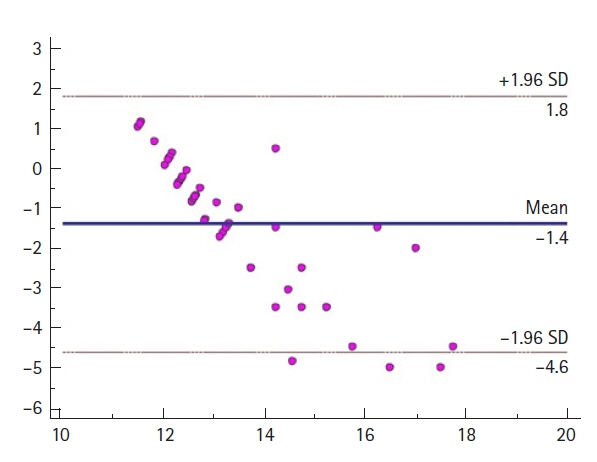Acute Crit Care.
2022 May;37(2):224-229. 10.4266/acc.2021.00787.
Determining the diagnostic value of tracheal intubation by palpation and auscultation methods compared to the chest X-ray method in children
- Affiliations
-
- 1Department of Anesthesiology, Anesthesiology and Critical Care Research Center, Chamran Hospital, Isfahan University of Medical Sciences
- 2Cardiac Rehabilitation Research Center, Chamran Hospital, Isfahan University of Medical Sciences
- KMID: 2531680
- DOI: http://doi.org/10.4266/acc.2021.00787
Abstract
- Background
It is important to determine the proper location of tracheal tube for proper ventilation. In this study, we compared the diagnostic value of tracheal intubation with two methods of palpation and auscultation with chest X-ray (CXR) method in pediatric.
Methods
In this interventional study, 80 patients under 6 years of age were included. After tracheal intubation appropriate depth of tracheal tube was determined by auscultation and recorded, then by palpation depth of tracheal tube determined and tube was fixed. The length of the tube was calculated with the standard formula based on age. After surgery, CXR was taken and, according to the landmark, the distance from the end of the tube to the anterior lower tooth was recorded.
Results
Interclass correlation coefficient (ICC) between the palpation method and the standard method in the number of fixing tracheal intubation was 0.573, which shows the average and significant correlation between these two methods in determining the fixed number of tracheal intubation. ICC between the auscultation and the standard method in fixing tracheal intubation number was 0.430, which shows the average and significant agreement between these two methods in determining the fixed number of tracheal intubation. There is no significant relationship between sex and the average number of fixing tracheal intubation in all methods.
Conclusions
This study has shown that both palpation and auscultation methods are appropriate, but with a slightly higher palpation ICC, the palpation can be considered relatively better.
Keyword
Figure
Reference
-
1. Merali HS, Tessaro MO, Ali KQ, Morris SK, Soofi SB, Ariff S. A novel training simulator for portable ultrasound identification of incorrect newborn endotracheal tube placement: observational diagnostic accuracy study protocol. BMC Pediatr. 2019; 19:434.2. Leone TA, Rich W, Finer NN. Neonatal intubation: success of pediatric trainees. J Pediatr. 2005; 146:638–41.
Article3. Jaeel P, Sheth M, Nguyen J. Ultrasonography for endotracheal tube position in infants and children. Eur J Pediatr. 2017; 176:293–300.
Article4. Haghani S, Shahnazi H, Hassanzadeh A. Effects of tailored health education program on overweight elementary school students' obesity-related lifestyle: a school-based interventional study. Oman Med J. 2017; 32:140–7.
Article5. Dongara AR, Modi JJ, Nimbalkar SM, Desai RG. Proficiency of residents and fellows in performing neonatal intubation. Indian Pediatr. 2014; 51:561–4.
Article6. Ebenebe CU, Deindl P, Wolf M, Jahn M, Singer D, Blohm ME. A prospective observational trial evaluating factors predictive of accurate endotracheal tube positioning in neonates and small infants. Paediatr Anaesth. 2020; 30:922–7.
Article7. Dominguez MC, Alvares BR. Pulmonary atelectasis in newborns with clinically treatable diseases who are on mechanical ventilation: clinical and radiological aspects. Radiol Bras. 2018; 51:20–5.
Article8. Rudraraju P, Eisen LA. Confirmation of endotracheal tube position: a narrative review. J Intensive Care Med. 2009; 24:283–92.
Article9. Im DD, Ross PA, Hotz J, Newth CJ. Evaluating the practice of repositioning endotracheal tubes in neonates and children based on radiographic location. Pediatr Crit Care Med. 2019; 20:1057–60.
Article10. Davis P, Cladis F. Smith's anesthesia for infants and children. 8th ed. New York: Mosby;2010.11. Maleki A, Ebrahim Soltani A, Takzare A, Espahbodi A, Goodarzi M, Noori R. Comparison of the three-finger tracheal palpation technique with triple ID formula to determine endotracheal tube depth in children 2-8 years in 2016-2017. World Fam Med. 2017; 15:48–53.
Article12. Okuyama M, Imai M, Sugawara K, Okuyama A, Kemmotsu O. Finding appropriate tube position by the cuff palpation method in children. Masui. 1995; 44:845–8.13. Moll J, Erb TO, Frei FJ. Assessment of three placement techniques for individualized positioning of the tip of the tracheal tube in children under the age of 4 years. Paediatr Anaesth. 2015; 25:379–85.
Article14. Yoo SY, Kim JH, Han SH, Oh AY. A comparative study of endotracheal tube positioning methods in children: safety from neck movement. Anesth Analg. 2007; 105:620–5.
Article15. McKay WP, Klonarakis J, Pelivanov V, O'Brien JM, Plewes C. Tracheal palpation to assess endotracheal tube depth: an exploratory study. Can J Anaesth. 2014; 61:229–34.
Article16. Saboo AR, Dutta S, Sodhi KS. Digital palpation of endotracheal tube tip as a method of confirming endotracheal tube position in neonates: an open-label, three-armed randomized controlled trial. Paediatr Anaesth. 2013; 23:934–9.
Article17. Bloch EC, Ossey K, Ginsberg B. Tracheal intubation in children: a new method for assuring correct depth of tube placement. Anesth Analg. 1988; 67:590–2.18. Hofer CK, Ganter M, Tucci M, Klaghofer R, Zollinger A. How reliable is length-based determination of body weight and tracheal tube size in the paediatric age group? The Broselow tape reconsidered. Br J Anaesth. 2002; 88:283–5.
Article19. Eagle CC. The relationship between a person's height and appropriate endotracheal tube length. Anaesth Intensive Care. 1992; 20:156–60.
Article
- Full Text Links
- Actions
-
Cited
- CITED
-
- Close
- Share
- Similar articles
-
- Effects of the Size of the Uncuffed Tracheal Tube on Verifying Tube Position by Auscultation in Children
- Proper Depth of Tracheal Intubation in Korean Children
- Incidence and Contributing Factors of Malpositioning of the Endotracheal Tube after Endotracheal Intubation with Chest X-ray
- Retrograde Tracheal Intubation through Cricothyroid Membrane and Cricotracheal Ligament
- Nonspecific Bronchial Reactivity Determined by Tidal Breathing Method and Chest Auscultation: A Comparison with Dosimeter Method-



